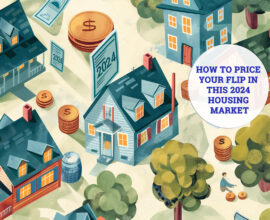Millennials Are More Desperate to Buy a Home in 2024 Than Ever Before!
It’s been a tough housing market. One group that’s been hit particularly hard is millennials — those born between 1981 and 1996 (currently everyone ages 28 to 43).
Although over half of millennials are now homeowners, it took them longer to reach this milestone compared to older generations. Last year, the median age for a first-time homebuyer was 36, compared to 29 for their parents’ generation.
Plus, many millennials are still trying to buy a home, getting more desperate by the year.
The fact is millennials are entering their prime homebuying years (25 to 45 years old). But unlike Generation X and baby boomers, millennials have had to face one of the toughest housing markets in recent history.
In this article, we’ll go over what those homebuying obstacles are, how millennials are responding, and what it all means for real estate investors.
Millennials also face steep competition from baby boomers.
Housing trends holding millennials back from homeownership
It’s no secret that we are experiencing a severe housing shortage. According to recent estimates, the U.S. is short about 3.2 million homes.
This is partly due to a construction lag. Since the 2008 housing crash, many builders have built at a slower pace to avoid getting stuck with inventory they can’t sell. In addition, supply and labor shortages — not to mention higher interest rates — have kept construction costs high.
Another reason for the low housing supply is a need for more existing homes for sale. Now that mortgage rates have shot up from their historic lows of 3-4% in 2020 and 2021, many homeowners are refusing to sell and give up their locked-in low rates, adding to the inventory deficit.
Of course, many millennials are hampered by obstacles on the demand side, too. For example, higher mortgage rates are making homeownership more expensive. As of January 4, 2024, the average 30-year fixed-rate mortgage is 6.62%. That’s better than the recent peak of 8%, but it’s still well above the sub-5% rates homebuyers have grown accustomed to over the last 15 years.
Millennials also face steep competition from baby boomers. Having lived and worked longer, boomers are more flush with cash and home equity and thus more able to make cash offers, which beat offers requiring financing with all else held equal. Now that mortgage rates are up, cash offers are booming. In January, they made up 29% of all existing home sales, up from 27% the year before. This helps explain why in 2022, boomers overtook millennials as the largest homebuying generation.
To make matters worse, many boomers are downsizing to smaller, starter homes to retire. Since builders are already building fewer of these to focus on more profitable, expensive homes, the barrier to entry for first-time buyers is even higher.
Another obstacle to homeownership includes wages not keeping up with home prices. According to the Federal Finance Housing Agency, home prices rose 74% from 2010 to 2022, while the average wage rose only 54% during the same period.
Finally, many millennials are burdened by student debt. As of 2023, the average millennial borrower has an outstanding student loan balance of over $42,600, and over 79% of millennials report that student debt is a problem for young people in the U.S.
As millennials continue to enter their prime homebuying years, the pressure and desire to buy a home will only increase.
Where do millennial homebuyers go from here?
Without a doubt, current housing trends paint a dire picture for millennial homebuyers: They’ve had to delay homeownership relative to older generations and miss out on years of building home equity.
However, there’s still hope, and many millennials are finding ways to adapt to their unique home-buying challenges.
For example, many millennials are choosing to move back in with their parents to save up for a down payment. In 2022, the number of first-time homebuyers who moved directly from a friend’s or family member’s home and into their own home hit 27%, the highest share since at least 1989.
Others are moving further away from cities, where homes are more affordable. This was especially true during the COVID-19 pandemic and the resulting government lockdowns and social distancing. Instead of being cramped in a small apartment, many moved to suburban and rural areas where they could spread out — what some observers have called “the most boring places in the world.”
The point is that the American dream of homeownership is alive and well. While some denounce it as outdated or unrealistic, most still want to settle down in a home they own. According to a recent Bankrate survey, nearly three-quarters of Americans place owning a home above career, family, and college as a sign of prosperity.
What millennials’ home buying challenges and opportunities mean for investors
So what does all this mean for real estate investors? Is there a way to capitalize on the homebuying challenges and opportunities of America’s largest generation?
The short answer is yes. As millennials continue to enter their prime homebuying years, the pressure and desire to buy a home will only increase. Real estate investors can take advantage of this trend by catering their business to first-time millennial buyers.
For example, flippers can focus on renovating distressed properties into starter homes. In addition, they can install smart home technology that younger buyers value, e.g. automated door locks and video doorbells.
You can also add dedicated home office spaces to your flips for millennials to work remotely. According to a 2022 Axios survey, millennials are driving the push to work from home. 84% of them say remote work is important vs. 66% of Gen Z, 75% of Gen X, and 68% of boomers.
Many millennials can’t afford a home on their own but may be open to buying with other family members or friends as co-owners.
Another way to cater to millennial homebuyers is to offer creative financing solutions. Some may not qualify for a traditional mortgage due to stricter lending standards but still be responsible borrowers. Consider the following:
- Seller financing. This involves lending to the homebuyer yourself. Essentially, you become the bank and collect payments (including interest) from the buyer over time.
- Lease option. This involves letting the buyer rent the property for a time with the option to buy it later at a predetermined price (aka rent-to-own). Often, a portion of the rent goes toward the eventual purchase.
- Crowdfunding. This involves letting multiple buyers go in on the property instead of just one. Many millennials can’t afford a home on their own but may be open to buying with other family members or friends as co-owners.
Moving forward, millennials will become increasingly interested in buying homes, and older generations will slowly age out of the market. So, it pays to start shaping your real estate investing business around millennials now.








